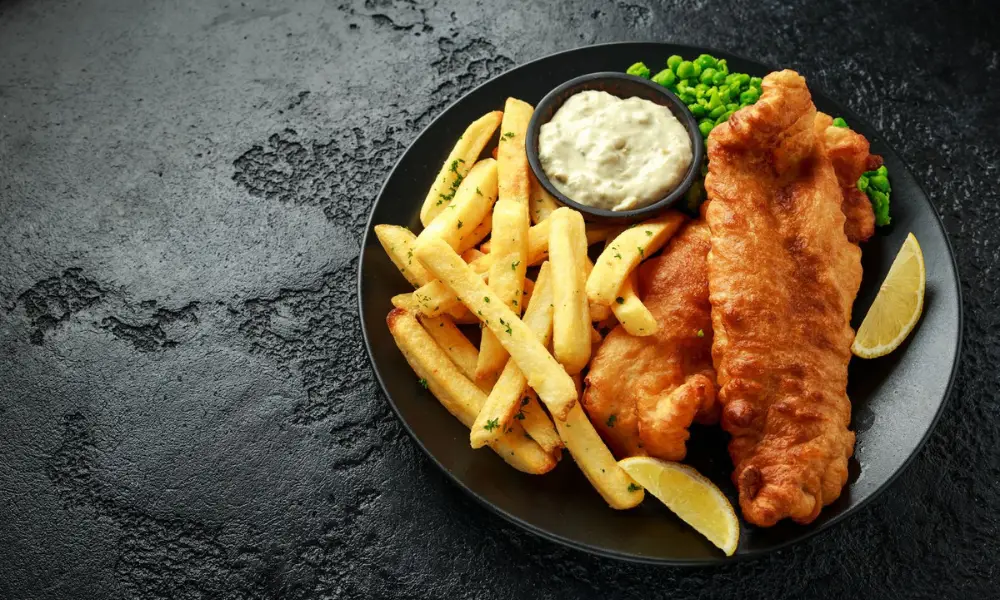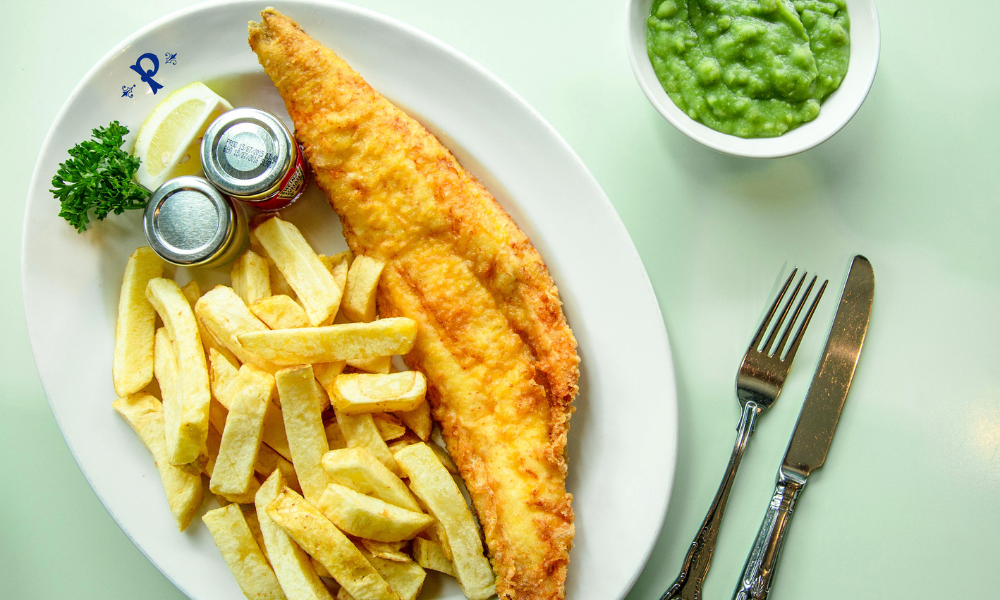Don’t throw away any leftover fish and chips from the chip shop! The following day, you can crisp them again using almost any cooking device.
This traditional British dish can be reheated in a variety of ways. Most people envision something gloppy and unpleasant when thinking about reheated fish and chips. You don’t have to waste food or accept cold leftovers, no matter what you have in your kitchen.
This need not be the case, though. The only reason leftovers are soggy is that you don’t know how to reheat them properly. Meals from a chip store that have just come out of the frying are unmatched. However, it can be rather close if you heat them properly.

What is Chip Shop?
A restaurant specializing in serving fish and chips is known as a “fish and chip shop,” also known as a “chip shop.” Fish and chip establishments mostly offer takeout service; however, some offer to dine. Fish and chip shops may also serve a variety of other cuisines, from regional cuisine like Greek or Indian food to variants on their standard menu like battered sausage and burgers.
Fish bars, fishery (in Yorkshire), fish shops, and chip shops are examples of name variations. They are known as chippies or fishies in the United Kingdom, which includes Northern Ireland, but chippers in the rest of Ireland and the Aberdeen region.
How to Reheat Chip Shop Chips?
You might be wondering how to reheat leftover fish and chips now that you know how to preserve them correctly.
The answer to that query will depend on the utilities you have in your home.
Here are the best methods for each appliance for reheating fish and chips.
Keep in mind that food that has been prepared and then cooled to be safe to eat must either be consumed cold or heated up to steaming hot.
In the Oven
Even though this approach takes the longest to complete, it is the simplest way to cook leftovers without additional oil.
Initialize your oven’s temperature to 175 degrees Celsius (350 degrees Fahrenheit). For simple cleanup, line a baking sheet with foil while it’s preheating. To avoid sticking, you should also spray it with cooking oil.
Evenly distribute the fish and chips on the pan. Never stack any chips on top of one another. Lastly, bake your chips for ten to fifteen minutes in the oven. It will be hot, crispy, and ready to eat when it’s finished!
Fat Fryer
Nowadays, most households do not have deep-fat fryers. However, restoring the popular fish and chips’ juicy, crispy flavor is a terrific method if you have access to one. Start by preheating the fryer with the oil of your choice.
Put your fish and chips in the frying basket after that. Cook them for two minutes or until the desired crispiness is reached. Remove your fish and chips from the frying basket after cooking.
This technique adds a lot of grease, so remove any extra with a paper towel before eating.
In a Frying Pan
If you don’t have access to a deep-fat fryer or an oven, this method can still get crispy results.
Your pan to medium-low heat first. To avoid sticking, use a nonstick pan or apply a little oil.
Place the fish and chips in the pan after that. Approximately 5 to 6 minutes should pass before flipping them. They will be ready to eat once they are hot throughout and have a crispy outside.
How to Freeze Chip Shop Chips?
You’ll surely be happy to hear that you can freeze any extra chips you couldn’t consume immediately if you ordered too many from the chip store.
As you can see from the procedures given below, freezing chip shop chips is rather simple:
Cool
Before freezing, your chip shop chips must have cooled to room temperature. Chips that are still warm when frozen will become soggy in the freezer.
Freeze at First
Lay your chips flat on a baking sheet lined with parchment paper, ensuring they are evenly spaced apart and not touching. After a few hours in the freezer, take off the tray when the chips are frozen.
Put it inside a Freezer Bag.
When your chips are frozen, empty them into a freezer-safe bag or container and seal them.
Identify and Freeze
Before putting the chips in the freezer, write today’s date and the use-by date on the front of the bag or container.
What is the Best Way to Defrost Chip Shop Chips?
Chips from the chip store can be warmed straight from the freezer, so there’s no need to thaw them first. When you’re ready to reheat them, take them out of the freezer and arrange them on a baking sheet, leaving plenty of space between them.
They can be enjoyed after being reheated in a 350°F/180°C oven for around 20 minutes.
However, chip shop chips can be defrosted by taking them out of the freezer and putting them in the refrigerator.
How to Store Chip Shop Chips?
By letting the air out of the bag and tightly rolling down the top, you may seal your bagged chips.
The firmly closed bag with a chip clip. Try securing your bag with a paperclip or a clothespin if you don’t have any chip clips.
Put your chips in a Ziploc bag and tightly seal them.
Remove all bags from your storage area and keep your chips in an airtight container.
These techniques can be used separately or in combination. As we’ve already mentioned, keeping your chips fresh requires keeping them out of the open air for extended periods.
If your chips are exposed to the air, they will stale rapidly.
Which Oil is Used to Fry Chip Shop Chips?
While the typical oil choice at home can vary depending on the dish, chip shops must use specified oil to keep the classic taste British customers demand.
You will typically find vegetable oil being used at chip businesses. Fortunately, it’s also broadly accessible outside of business contexts! Vegetable oil is frequently used in chip shops because of its mild flavor.
You can cover your chips in a variety of favorite chip shop sauces. Typically, gravy or curry sauce are the best options.
The reasons why chip establishments often do not use alternative oils are pretty straightforward. First, many alternative oils are much more expensive and, therefore, not worthwhile. Some more upscale chip establishments may use canola oil, but why repair something that isn’t broken?
Second, quite a few oils would fall short of providing the same texture and flavor. Oils are not created equal! For instance, it would be unwise to fry standard chip shop-type chips in olive oil.
Not just because it gives the potato a very distinct flavor but also because it would change the crucial crunch!
How Long do Chip Shop Chips Last in the Fridge?
Once cooked, chip shop chips can be stored in the refrigerator for up to 5 days. The chips from the chip shop shouldn’t be refrigerated because you don’t know how long they have been manufactured in advance or whether they have already been warmed up.
Making your chip shop chips also benefits from being frozen raw and used for up to 6 months. Just take them out of the freezer and cook them for 20 to 22 minutes! Frozen homemade chips!
To avoid having your chips sit about at room temperature, put them in the freezer as soon as they have cooled. This maintains their excellent flavor and guarantees they will remain flavorful after being frozen.
What to do with the Remaining Chip Shop Chips from Last Night?
The day after visiting a chip shop, you can enjoy a fantastic supper made with leftover fish and chips. After all, the amounts are frequently quite substantial, so leaving without having leftovers is difficult.
The leftovers from the chip store are frequently thrown away or never brought home. However, you can prevent food waste with access to a refrigerator and cooking equipment!
You won’t want to toss away leftover fish and chips once you learn the best methods.
Leftover fish and chips can be delectable whether you eat them for lunch, supper, an odd breakfast, or even a late-night snack.
Try spicing up your leftover fish and chips for even better results. It will taste like you just took it home from the chip shop if you serve it with tartar sauce or smear it with lemon juice!
How to Tell Chip Shop Chips are Gone Bad?
It’s time to throw out your chips if they smell terrible, have a different color, or have mold growing on them.
Never attempt to eat spoiled food. It won’t only taste horrible, but it can also give you the flu.
Keep your fish and chips in the refrigerator as soon as possible in a tightly closed container, and consume them within three days to avoid them going bad. The chips will become soggy and may contain many bacterias that can be harmful to the health.
What are the Side Effects of Consuming Chip Shop Chips?
Gaining Weight
The usual high fat and calorie content of chips can increase the risk of weight gain and obesity. About 15 to 20 chips, or one ounce of ordinary potato chips, have 154 calories and 10 grams of fat. According to a 2015 study published in “Health Affairs,” potatoes fried in oil (including chips) are among the foods most significantly associated with weight gain. Diabetes, heart disease, and some types of cancer are all made more likely by being overweight or obese.
A Poor Diet
You might not get all the nutrients you need if chips are a frequent component of your diet. Chips often lack vitamins and minerals and frequently replace foods that are richer in these nutrients. Eating healthy snacks can help compensate for any nutritional lack at meal times, so if you opt for chips instead of snacks with a high nutrient density, you won’t get this benefit.
Elevated Cholesterol
The quantity and kind of fat included in chips might raise cholesterol levels when consumed often. Most chips are deep-fried, producing trans fats, the most harmful kind. Additionally, the oils used to fry chips are frequently saturated fats, raising cholesterol levels. High levels of LDL cholesterol and an increased risk of coronary heart disease are linked to high amounts of trans fats in the bloodstream. Trans fat levels in the blood are connected with diets high in trans fat.
Reference: Effect of the Moderate Consumption of Olestra in P Receiving Long-term Warfarin Therapy
Three patients in the olestra group and five in the placebo group experienced gastrointestinal side effects (diarrhea, gas, bloating) (p=0.3). In patients taking warfarin for long periods, moderate consumption of snacks containing olestra did not significantly change the INR (> 0.3 U) at one week. After two weeks, it does not seem that moderate consumption of these snacks would alter the INR, but this needs to be proven in a larger sample with sufficient power.
Conclusion
Whether you’ve had a great meal at the chip shop or want to make a batch of crispy chips at home, an air fryer can help you reheat chip shop chips to perfection. The air fryer removes moisture and makes the crust crispy. It can also be used to reheat leftovers.
The chips should be reheated on medium-high heat. You can also use a microwave for this step. If you’re worried about bacteria growing in the microwave, you can use a convection oven instead. Convection ovens can cook food at a lower temperature than a regular oven, saving you time.
